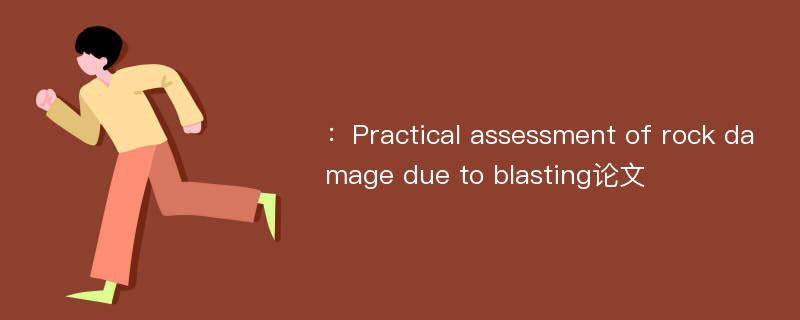
本文主要研究内容
作者(2019)在《Practical assessment of rock damage due to blasting》一文中研究指出:Blasting is the most cost effective methodology to break rock for mining or civil engineering applications.A good production blast will break only the rock that is needed to be removed, leaving the host rock with minimal damage. The control of rock damage due to blasting is very important when it comes to mine or construction design, safety, and cost. Damage to the host rock due to a production blast could result in failures, overbreak and unstable ground. Knowing how far the fractures generated by a production blast will go into the host rock is a valuable tool for engineers to design a safe highwall while keeping the actual excavation close to the design. Currently, there are several methods available to predict damage due to blasting. The accuracy of many of these methods is questionable, and in most cases, the methodologies over predict the results. This often leads to inefficient mines and poor construction works. When the current methodologies are reviewed, each one presents sound approaches, but in many cases they also lack consideration of other variables that, according to the authors, need to be included when predicting blast damage. This paper presents a practical methodology to assess the rock damage from blasting by combining other methodologies. The proposed method allows consideration of more variables when compared to available methods, resulting in a more accurate rock damage assessment. The method uses the estimation of the generated levels of peak particle velocity with the distance from a production blast presented by Persson and Holmberg, the peak particle velocity damage ranges proposed by Forsyth and the relationship between the static compressive strength and dynamic compressive strength of rocks from Liu. The new methodology was validated using the data published in a large-scale study performed in granite by Siskind.
Abstract
Blasting is the most cost effective methodology to break rock for mining or civil engineering applications.A good production blast will break only the rock that is needed to be removed, leaving the host rock with minimal damage. The control of rock damage due to blasting is very important when it comes to mine or construction design, safety, and cost. Damage to the host rock due to a production blast could result in failures, overbreak and unstable ground. Knowing how far the fractures generated by a production blast will go into the host rock is a valuable tool for engineers to design a safe highwall while keeping the actual excavation close to the design. Currently, there are several methods available to predict damage due to blasting. The accuracy of many of these methods is questionable, and in most cases, the methodologies over predict the results. This often leads to inefficient mines and poor construction works. When the current methodologies are reviewed, each one presents sound approaches, but in many cases they also lack consideration of other variables that, according to the authors, need to be included when predicting blast damage. This paper presents a practical methodology to assess the rock damage from blasting by combining other methodologies. The proposed method allows consideration of more variables when compared to available methods, resulting in a more accurate rock damage assessment. The method uses the estimation of the generated levels of peak particle velocity with the distance from a production blast presented by Persson and Holmberg, the peak particle velocity damage ranges proposed by Forsyth and the relationship between the static compressive strength and dynamic compressive strength of rocks from Liu. The new methodology was validated using the data published in a large-scale study performed in granite by Siskind.
论文参考文献
论文详细介绍
论文作者分别是来自International Journal of Mining Science and Technology的,发表于刊物International Journal of Mining Science and Technology2019年03期论文,是一篇关于,International Journal of Mining Science and Technology2019年03期论文的文章。本文可供学术参考使用,各位学者可以免费参考阅读下载,文章观点不代表本站观点,资料来自International Journal of Mining Science and Technology2019年03期论文网站,若本站收录的文献无意侵犯了您的著作版权,请联系我们删除。
标签:International Journal of Mining Science and Technology2019年03期论文;
